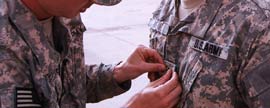Yes it can be used as corrective training if the rules are followed
In your example this is not the proper application or execution of using Physical Training as Corrective Training.
AR 600-20 and FM 7-22 contact information on using physical fitness as corrective training. Keep in mind this is not designed to smoke the Soldier but to gain their attention. Leaders that improperly use this as a method of punishment can be perceived as abusing their subordinates and or potentially cause injury to the Soldier. Leaders at all levels have responsibility to educate leaders on the correct implementation of corrective training and not allow leaders to abuse this method of corrective action. Extracts of the reg and TC follow?
AR 600-20 paragraph 4-20a (2) under hazing authorizes the following:
(2) When authorized by the chain of command and not unnecessarily cruel, abusive, oppressive, or harmful, the following activities do not constitute hazing:
(a) The physical and mental hardships associated with operations or operational training.
(b) Administrative corrective measures, including verbal reprimands and a reasonable number of repetitions of
authorized physical exercises.
(c) Extra military instruction or training.
(d) Physical training (PT) or remedial PT.
(e) Other similar activities.
(b) above appears to authorize physical exercise for corrective training regardless of the infraction. Does this mean corrective training does not have to be related to the offense. For example: you are late to formation and I make you do 10 pushups?
FM 7-22.
Paragraph 5-15 of that TC stipulate the following:
Corrective Action
5-15. When exercise is used for corrective action, it is often performed incorrectly, promoting overtraining
syndrome, and overuse injuries. Often corrective action mimics “smoke sessions,” punishing Soldiers with little
or no corrective value. Consideration must be given to the number of times per day exercises are used for
corrective action for individual Soldiers and groups of Soldiers to avoid the cumulative effect and limit the
potential for over training syndrome. The following guidelines should be followed when employing exercise as
corrective action.
· Only the following exercises should be selected for performance of corrective action.
- Rower. ·
- Squat bender.
- Windmill.
- Prone row.
- Push-up.
- V-up.
- Leg tuck and twist
- Supine bicycle.
- Swimmer.
- 8-count push-up.
· Only one of the above exercises may be selected for each corrective action.
· The number of repetitions should not exceed FIVE for any one of the exercises listed above.
So, you can only have the Soldier perform one of the above listed exercises and you can only make them do 5 repetitions.
Use this information to educate your Soldiers and leaders….do not abuse your Soldiers!
What happens if a Leader fails to follow these procedures?
Keep in mind that Leaders who circumvent this process and use other exercises or fail to follow these rules become totally responsible for the health and welfare of the Soldier. They can be held legal responsible if the Soldier is injured or abused.
It is a culture that is embedded into the Army about “smoke” sessions that is going to take a while to get some older NCO’s, to accept the change. A lot of it is just educating of the masses.













